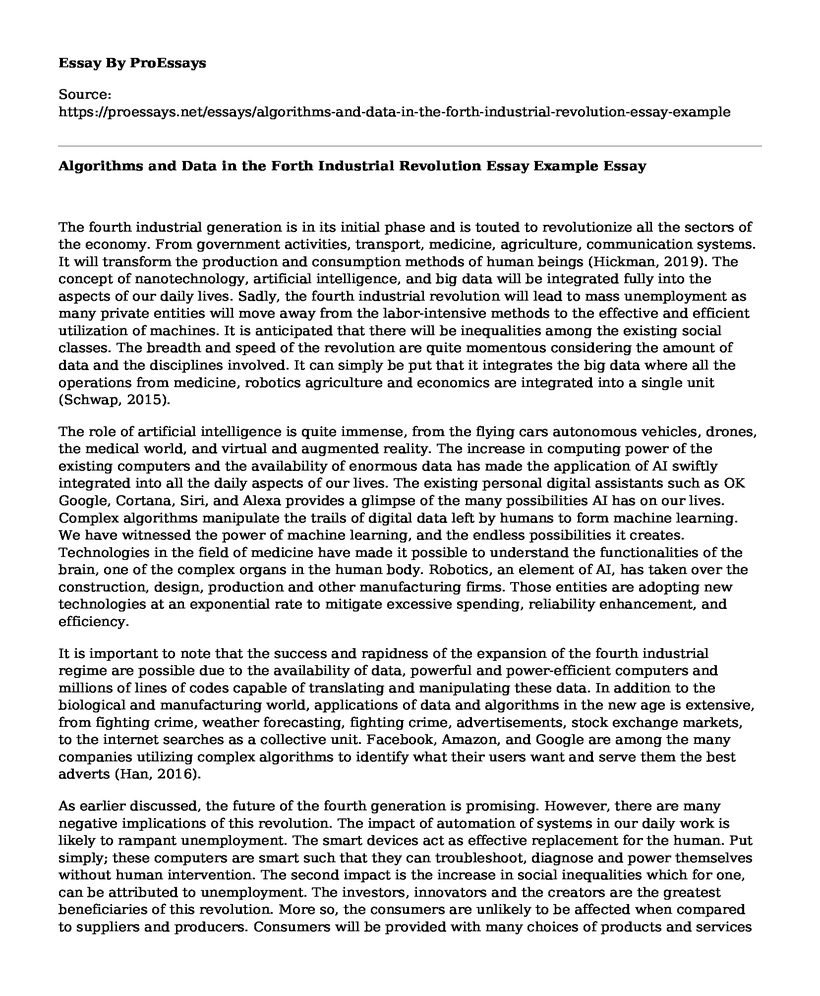The fourth industrial generation is in its initial phase and is touted to revolutionize all the sectors of the economy. From government activities, transport, medicine, agriculture, communication systems. It will transform the production and consumption methods of human beings (Hickman, 2019). The concept of nanotechnology, artificial intelligence, and big data will be integrated fully into the aspects of our daily lives. Sadly, the fourth industrial revolution will lead to mass unemployment as many private entities will move away from the labor-intensive methods to the effective and efficient utilization of machines. It is anticipated that there will be inequalities among the existing social classes. The breadth and speed of the revolution are quite momentous considering the amount of data and the disciplines involved. It can simply be put that it integrates the big data where all the operations from medicine, robotics agriculture and economics are integrated into a single unit (Schwap, 2015).
The role of artificial intelligence is quite immense, from the flying cars autonomous vehicles, drones, the medical world, and virtual and augmented reality. The increase in computing power of the existing computers and the availability of enormous data has made the application of AI swiftly integrated into all the daily aspects of our lives. The existing personal digital assistants such as OK Google, Cortana, Siri, and Alexa provides a glimpse of the many possibilities AI has on our lives. Complex algorithms manipulate the trails of digital data left by humans to form machine learning. We have witnessed the power of machine learning, and the endless possibilities it creates. Technologies in the field of medicine have made it possible to understand the functionalities of the brain, one of the complex organs in the human body. Robotics, an element of AI, has taken over the construction, design, production and other manufacturing firms. Those entities are adopting new technologies at an exponential rate to mitigate excessive spending, reliability enhancement, and efficiency.
It is important to note that the success and rapidness of the expansion of the fourth industrial regime are possible due to the availability of data, powerful and power-efficient computers and millions of lines of codes capable of translating and manipulating these data. In addition to the biological and manufacturing world, applications of data and algorithms in the new age is extensive, from fighting crime, weather forecasting, fighting crime, advertisements, stock exchange markets, to the internet searches as a collective unit. Facebook, Amazon, and Google are among the many companies utilizing complex algorithms to identify what their users want and serve them the best adverts (Han, 2016).
As earlier discussed, the future of the fourth generation is promising. However, there are many negative implications of this revolution. The impact of automation of systems in our daily work is likely to rampant unemployment. The smart devices act as effective replacement for the human. Put simply; these computers are smart such that they can troubleshoot, diagnose and power themselves without human intervention. The second impact is the increase in social inequalities which for one, can be attributed to unemployment. The investors, innovators and the creators are the greatest beneficiaries of this revolution. More so, the consumers are unlikely to be affected when compared to suppliers and producers. Consumers will be provided with many choices of products and services to pick from. However, consumers privacy is a point of concern since the design of these complex technological units is based on data collected from them.
Conclusion
To conclude, data and algorithms are the driving forces of the fourth industrial revolution, a paradigm shift in the way humans operate and relate to the machines. These changes are rapid, extensive and possibly inevitably difficult to ignore. In all of these, the major deterrent to fullest implementation of the future technologies in this era of the fourth industrial revolution is the effect of climate change unless utilized to create artificial forests or even make humans multi-planetary.
References
Han, D. (2016). University Education and Contents in The Fourth Industrial Revolution. Humanities Contens, 42, p.9.
Hickman, L. (2019). How algorithms rule the world. [online] the Guardian. Available at: https://www.theguardian.com/science/2013/jul/01/how-algorithms-rule-world-nsa [Accessed 27 Mar. 2019].
Schwap, K. (2015). The Fourth Industrial Revolution. [online] Luminariaz.files.wordpress.com. Available at: https://luminariaz.files.wordpress.com/2017/11/the-fourth-industrial-revolution-2016-21.pdf [Accessed 27 Mar. 2019].
YouTube. (2016). What is the Fourth Industrial Revolution?. [online] Available at: https://www.youtube.com/watch?time_continue=1&v=kpW9JcWxKq0 [Accessed 27 Mar. 2019].
Cite this page
Algorithms and Data in the Forth Industrial Revolution Essay Example. (2022, Dec 06). Retrieved from https://proessays.net/essays/algorithms-and-data-in-the-forth-industrial-revolution-essay-example
If you are the original author of this essay and no longer wish to have it published on the ProEssays website, please click below to request its removal:
- The Age of the Late Renaissance in England Essay
- America Divided: The Civil War of the 1960s - Essay Sample
- Iraq War: US Armed Conflict 2003-2011 - Essay Sample
- Essay Example on the Lives of Marcus Garvey and Martin Luther King
- Essay Example on Manifest Destiny & Alexander Graham Bell: Pioneering the American Missionary Association
- Essay Sample on Civil War Ends With Robert E. Lee's Last Attempt at Gettysburg
- Essay Example on Vonnegut's Slaughter House Five







